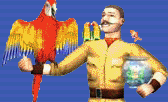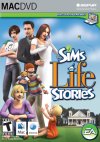Fansite and affiliate SimsNetwork has received scans of next month's Official Nintendo Magazine UK (ONM). Like we reported earlier, this magazine has a feature about the recently announced MySims. The scans, which you can find below, reveal some new information about the Wii version of the game. They comment that recent installments of the Sims series have seen slipping review scores, but that, inspired by Nintendo's innovation, EA has seen what's possible with Nintendo's latest platforms. See the scans below, or read on for details from the preview.
Editors of the magazine were invited to EA Redwood Shores, where the Sims Division is headquartered, where they were able to play an early edition of MySims for the Wii. They say that when you start the game for the first time, it'll be like right after you unpacked your Wii and booted it for the first time: you'll be spending plenty of time checking out the options for customising your Sim using the Wii Remote. The characters have a unique style, designed by Emmy Toyonaga. They resemble 3D equivalents of Comedy Central's South Park characters, but with a classical Japanese twist.The first session of the game will consist of simply wandering around, chatting to the people in the town and exploring the rundown village. The controls are simple: the analogue stick will make your Sim walk around, and the Nunchuk's C and Z buttons will focus the camera and interact with Sims and items. A relationship menu will allow you to check out who likes you and who doesn't. This menu will be essential later in the game, but until then it's best to be as nice as possible to everybody in the town. Socialising is similar to the classic Sims games, and helps you get to know the other Sims, but it's only the beginning: after a little while you'll need to help the other inhabitants to make the town grow.
The article also explains the building method of the pizza oven and buildings. For a specific object, like the oven, you'll be given a wireframe of what you need to build, and drop the building blocks on that. A chime will tell you that you're done, though you can still further customise the object. After giving the oven to the Italian chef, you'll instantly achieve gratification and a loving relationship. Current inhabitants will be happier, and more people will come to your town as a result. Later on in the game friends will even ask you to completely remodel their houses, which is similar to building an object. Drag and drop blocks, add the doors, windows, signs, roofs and even rooftop swimming pools, and your town will look like anything "from a swathe of '70s concrete tower blocks to a season of MTV's tacktastic Cribs."
The blocks and their colours can result in any number of outcomes, though you will be craving for more stuff to play with. That's where Essences start playing a role. Through exploring, helping and digging you will receive new items to use. You may receive a flower, a special tool or just some dirt or a brick with a strange colour. Your Sim will extract the Essence of the item you reveice, and it'll be added to your paint box. For example, if you see a piece of pine lying somewhere in the area, you can extract its Essence and colour your creations with a pine effect.
While at first it'll pay off to be nice to other Sims, you may also get new Essences if you're mean to others, if you keep the relationships in balance: "For instance, by blowing into a paper bag and popping it behind Clara's back, you can make her jump three feet into the air, [...] and sometimesy ou'll be rewarded with a 'scary' Essence." There are also Biomes, living things in the world (plants, trees, fruit, vegetables and animals).You can plant an orchard from seed, harvest crops or plant flowers. Biomes can be turned in to Essences or building blocks, for example using sunflowers as stools. Giving a particularly impressive Biome-based item away as a present will get you a friend for life. The more Biomes you place around the town, the happier it will become.
The ONM preview also talks about a Volcano area where people who won't come to your village have set up home. There are ways to tempt the characters back to your town. You can source building blocks and essences from the area, and working hard enough you may be able to lure back Sims from the Volcano village back to yours, by building a volcano-themed building. Rare items like Obsidian lamps, which will please your own town's inhabitants, can also be found in the distant area.
Some questions can't be answered yet, specifically sound, downloadable items (through WiiConnect24), playing your own MP3s, and a DS-Wii Wi-Fi link between the two versions of the game. Answers simply aren't available yet, this early in development of the game. Fans of The Sims, Harvest Moon or Animal Crossing should, according to the magazine, all keep an eye on the title. The magazine also promises an exclusive in-depth preview of the DS version soon.
The magazine already does mention a little bit about the DS version though, which is being developed in Japan. ONM did get a hands-on opportunity with an early version of the handheld game, which is looking promising, but it's just not as complete as the Wii version yet.
Two more pages in the middle of the special contain short interviews with Rod Humble (Head of Studio), Tim LeTourneau (Executive Producer), Robin Hunicke (Lead Designer), Terry Smith (Art Director) and Goopy Rossi (Animation Director). Humble explains that full production on the game started mid-2006, and work is being done by 80 people for the Wii and another 30-ish for the DS versions.
About the comparison with Animal Crossing, Humble tells that the team for Animal Crossing was inspired by the Sims, but MySims is different. It's not about collecting, but building a world. Hunicke also says Animal Crossing also has passing time, with people moving in and out, with consequences if you don't do something. MySims gives you "an opportunity to be creative in a place where the characters are actually quite smart." Rod Humble also explains the main difference between MySims and the rest of the Sims series: the depth of construction - you build rather than buying from a catalogue.
The custom soundtrack feature and WiiConnect24 capabilities, mentioned before, are also discussed during the interview. While the team wants to do a lot with the new platform, it's still too early to talk about some of those features, say LeTourneau and Hunicke. They also tell about the Relationships menu: new people won't know you that well yet, and inhabitants will ahve social barriers. Do something for them and they might do something in return, give them something and you might receive something. The relationship score will determine what people are willing to say to you, which makes the characters feel smart. Pranks also have an effect on the relationships, possibly giving you spooky items.
Terry Smith explains how Emmy Toyonaga designed the characters, and how the rest of the world was created around those creations. Toyonaga explains that Mario and other Nintendo characters are short and stubby, and with her Japanese background she's used to the "mindset that fun games should have shorter, stubbier characters." Smith also says that the team is still tweaking the style, and perfecting the game for the Wii hardware. Technical things like shaders and lighting are still being figured out.
Finally, Goopy Rossi explains that he's glad he worked on a PC Sims game before MySims. Differences were needed for MySims, for example the gameplay having to be active all the time. The animations are shorter than the long-winded ones on the PC. He anecdotes work he did in Japan, where animation was "a bit of an afterthought." Characters didn't move in an interesting way.
Written at 03:12 on Wednesday, 28 February 2007 by ChEeTaH.
























